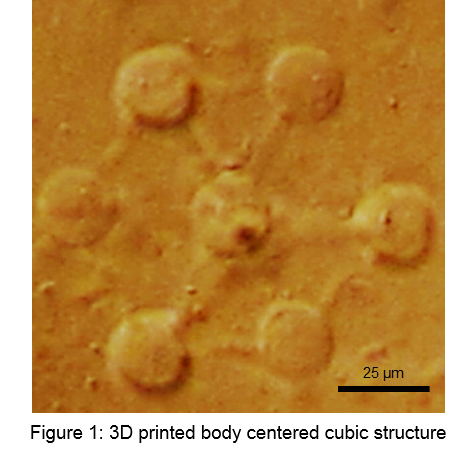Introduction: Poly(vinyl alcohol) (PVA) is a water soluble, odorless, tasteless, white and non-toxic polymer widely used in industry, e.g., as additive to food and cosmetic products. These properties, taken together with the sheer endless possibilities for chemical modification of the free secondary hydroxyl groups makes it especially interesting for the design of hydrogels for biomedical applications. In this paper, a modular system is created, combining ene-functionalized with thiol-functionalized PVA to thiol-ene based photo-curable hydrogel formulations [1] which can be processed by laser microfabrication.
Materials and Methods: Differently functionalized PVAs were synthesized by acid catalyzed ring-opening addition of according heterocycles to free hydroxyl groups. PVA-allyl (PVA-A) was obtained from allylsuccinic anhydride, PVA-norbornene (PVA-N) from cis-5-norbornene-endo-2,3-dicarboxylic anhydride, and PVA-thiol (PVA-T) from g‑thiobutyrolactone. Cytocompatibility of the macromeres was assessed by metabolic assay. In order to elucidate structure-properties relationships PVA-A, PVA-N, and PVA-T with different degree of substitution (DS) were photo-crosslinked while monitored with rheology. Dithiothreitol (DTT) was taken as low molecular weight reference thiol. The slope of the storage modulus from these photorheometric curves was taken as a measure for the reactivity whereas the final storage modulus as reference value for the crosslink density. Additionally, the swellability of ready-cured hydrogels was determined. Arbitrary structures of an optimized PVA-based hydrogel formulation were manufactured by two-photon microfabrication [2].
Results: PVA-A, PVA-N, and PVA-T were obtained with each two different DS by adjusting stoichiometry. It was found that all PVA modifications have a comparable good cytocompatibility, which generally decreased with macromere content and DS. In order to investigate an optimal thiol to ene ratio PVA-A and PVA-N were combined with different amounts of DTT in photorheologic measurements. The found optimum of 60 mol% thiol was confirmed in formulations with PVA-T. These measurements also showed that the photoreactivity and crosslink density of formulations with 15 wt% macromer with PVA-N as ene-component were higher compared to similar formulations with PVA-A. This was also confirmed by the higher swellability of hydrogels composed of PVA-A. Optimized formulations could be processed by two-photon lithography (Figure 1).

Discussion: The photoreactivity and cytocompatibility of the PVA based hydrogel precursors as well as the mechanical properties of the final hydrogels is highly influenced by the introduced reactive groups and their ratio. However, with the found optimal formulations the microfabrication of 3D hydrogel constructs was enabled. The wider processing window of PVA-N compared to PVA-A was also found as a manifestation of the higher photoreactivity of norbornene compared to allyl groups.
Conclusion: Both macromere thiol-ene systems are suitable to be processed by laser microfabrication based on two-photon lithography. However, PVA-A combined with PVA-T emphasized to be the system with higher cytocompatibility and should therefore be considered as basis for biocompatible 3D hydrogel while PVA-N/PVA-T has a higher photoreactivity and thus can be fabricated with higher laser scanning speeds.
Austrian research funding association (FFG, project number 849787); European Research Council (Starting Grant-307701, A.O.)
References:
[1] Torgersen, J.; Qin, X.-H.; Li, Z.; Ovsianikov, A.; Liska, R.; Stampfl, J. Adv. Funct. Mater. 2013, 23, (36), 4542-4554
[2] Hoyle, C. E.; Lowe, A. B.; Bowman, C. N. Chem. Soc. Rev. 2010, 39, (4), 1355-1387.